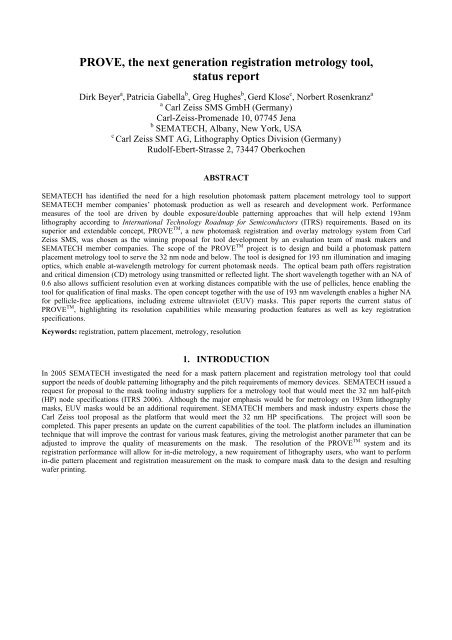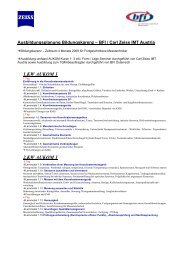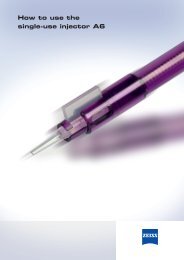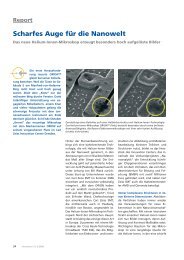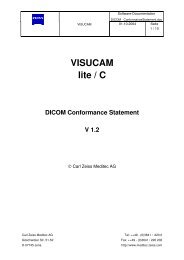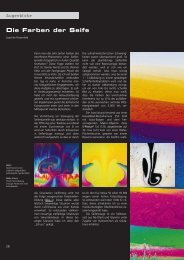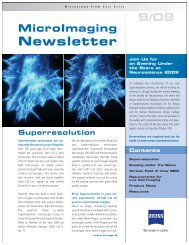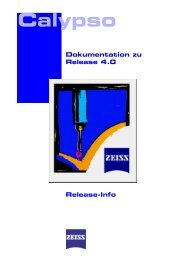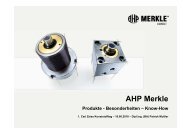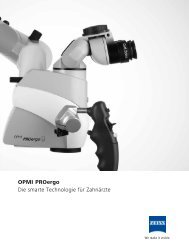PROVE, the next generation registration metrology tool ... - Carl Zeiss
PROVE, the next generation registration metrology tool ... - Carl Zeiss
PROVE, the next generation registration metrology tool ... - Carl Zeiss
- No tags were found...
You also want an ePaper? Increase the reach of your titles
YUMPU automatically turns print PDFs into web optimized ePapers that Google loves.
Fig. 3: Dynamic repeatability performance evaluated over 5 consecutive days on a 14 x 14 grid. The maximum 3sigmafor <strong>the</strong> x-direction is 0.96 nm and 0.73 nm for <strong>the</strong> y direction. The highlighted first four measurement sites indicate afirst-loop effect from insufficient <strong>the</strong>rmalization.Fig. 4: Dynamic repeatability performance without <strong>the</strong> first four measurement sites. The maximum 3sigma for <strong>the</strong> x-direction is now 0.79 nm and 0.69 nm for <strong>the</strong> y direction
3.3 Screen LinearityA screen linearity evaluation was performed after an optics calibration for <strong>the</strong> complete field of view using dedicated testmarkers. Figure 5 displays <strong>the</strong> measurement results for 81 sites. The maximum deviation for all sites is well below 0.8nm.X [nm]Y [nm]Field Y [µm]Max dev.Max3sigma0.780.380.710.48Field X [µm]Fig. 5: Screen linearity evaluation over a 20 µm field of view with optics calibration. The graph displays <strong>the</strong>measurement sequence over 81 sites. The maximum deviation corresponds to 0.78 in x- and 0.71 in y-direction.4. RESOLUTION ENHANCEMENTSThe imaging performance of <strong>the</strong> most advanced <strong>registration</strong> <strong>metrology</strong> <strong>tool</strong> depends on <strong>the</strong> interaction of differentoptical components, <strong>the</strong> illumination, <strong>the</strong> object to be imaged, and <strong>the</strong> imaging optic. The objects under investigation arevarious masks types such as standard chrome-on-glass (COG), opaque MoSi-on-glass (OMOG), or EUV, all that are tobe measured in transmission or reflection. The benefit of a shorter illumination wavelength has already been discussed in[3]. Based on extensive optical simulations, it could be demonstrated that <strong>the</strong> chosen wavelength of 193 nm at a 0.6 NAenables superior resolution for different types of photomask and production features to be imaged and measured for<strong>registration</strong>. The benefits of this additional knob to increase contrast and resolution have been investigatedexperimentally and first results are shown in Figure 6.
Optimizedillumination AOptimizedillumination BcircularFig. 6: Improved contrast by means of optimized illumination for 180nm dense contacts (COG mask). The inset displaysa zoom into <strong>the</strong> measurement image.While <strong>the</strong> dimension and shape of <strong>the</strong> structure under investigation affect <strong>the</strong> contrast, this can be partially compensatedby adjusting <strong>the</strong> illumination properties. Figure 6 displays <strong>the</strong> benefit of optimized illumination methods for contrastenhancement on real images of 180nm dense contacts. The rectangular shape of <strong>the</strong> 180nm contacts can be imaged byillumination method B only, hence giving <strong>the</strong> <strong>registration</strong> <strong>tool</strong> <strong>the</strong> capability to evaluate <strong>the</strong> right edge position. Thisclearly shows that <strong>the</strong> adapted illumination can significantly help to achieve better performance, in particular for lowcontrast images at <strong>the</strong> resolution limit, where already slight improvements can reduce <strong>the</strong> impact of image noise on <strong>the</strong><strong>registration</strong> error.5. CONCLUSIONThe paper presents <strong>the</strong> current status of <strong>the</strong> <strong>PROVE</strong> TM <strong>tool</strong>’s measurement capabilities. The first <strong>registration</strong> data showthat <strong>the</strong> system offers <strong>the</strong> measurement performance required for <strong>the</strong> 32 nm HP requirements for mask pattern placement<strong>metrology</strong>. Although originally specified using <strong>the</strong> 2005 ITRS, <strong>the</strong> resolution is still consistent with 2009 ITRSrequirements. This capability is necessary for <strong>the</strong> critical demands of current 193 nm lithography processing, includingdouble patterning lithography, and of <strong>the</strong> tight pitch requirements for memory devices. These results would not bepossible without <strong>the</strong> new state-of-<strong>the</strong>-art environmental control system and 193nm illumination. In addition, <strong>the</strong>illumination flexibility will provide better contrast for certain in-die mask features that need to be measured.ACKNOWLEDGEMENTSThe authors would like to thank <strong>the</strong> <strong>PROVE</strong> TM development team as well as SEMATECH for <strong>the</strong>ir support under <strong>the</strong>LITG 325contract.
REFERENCES[1][2][3][4][5][6]Klose, G., et al., “High resolution and high precision pattern placement <strong>metrology</strong> for <strong>the</strong> 45 nm node and beyond,”EMLC 2008, VDE Verlag, 233 – 238.Klose, G., et al., “<strong>PROVE</strong>: a photomask <strong>registration</strong> and overlay <strong>metrology</strong> system for <strong>the</strong> 45 nm node and beyond,”Proceedings of SPIE Vol. 7028 (2008).Klose, G., et al., “Photomask Registration and Overlay Metrology by means of 193 nm Optics,” Proceedings ofSPIE Vol. 7122 (2008).Huebel, A., et al., “Calibration strategies for precision stages in state-of-<strong>the</strong>-art <strong>registration</strong> <strong>metrology</strong>,” Proceedingsof SPIE, Vol. 7379 (2009)Arnz, M., et al., “Monte-<strong>Carl</strong>o Simulations of Image Analysis for flexible and high-resolution RegistrationMetrology,” Proceedings of SPIE, Vol. 7479 (2009).Beyer, D., et al., “In-die <strong>metrology</strong> on photomasks for low k 1 lithography,” Proceedings of SPIE, Vol. 7488 (2009).


